TWICE ITALY’S BEST PASTRY-CHEF IS FROM JAPAN
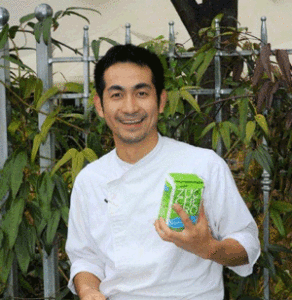
Interview ©2011
Tatsuya Iwasaki was born 34 years ago in the Japanese city of Saitama located10 to 15 miles north of Tokyo. After obtaining his diploma as a professional chef from the Hanasaki Tokuharu High School, he got his first job at the Sabatini Firenze in Tokyo. Ten years ago he moved to Italy, cooking in Sicily at Palermo’s fashionable Bye Bye Blues and at Pino Cutaia’s Madia in Licata near Agrigento, and in 2004 landed at the restaurant Agli Amici in Udine, where the chef /owner Emanuele Scarello immediately understood his potential. After working in almost all the departments of the kitchen there, he started taking charge of the bread and pastries. In 2009 L’Espresso’s guide to Italian restaurants awarded him the title of Italy’s best pastry-chef of the year. This year the international chef congress IdentitàGolose awarded him the same title.
During a press trip organized in December 2009 by Buon Italia for Italy’s Ministry of Agriculture I first met Tatsuya Iwasaki when I ate dinner at Agli Amici and interviewed its owner and chef Emanuele Scarello (Epicurean-Traveler.com, April 2010). We met again this January for a chat at IdentitàGolose’s splendid anuual three-day food kermesse in Milan. A few minutes earlier he had finished his hour-long demo and tasting of two of his “classic” desserts: “Like Breakfast” and “Beyond Strudel,” which had been my dessert during Buon Italia’s press trip. Sublime then and now!
Our tastes in food are closely connected to our childhood; what are your first memories of food?
TI: All my life I’ve loved steamed rice with vegetables and curried meat.
Of sweets?
TI: As a child I didn’t often eat sweets, except once in a while I’d get a vanilla softee at my aunt’s grocery store.
Of Italian food?
TI: Gli spaghetti alla Bolognese out of a can. At home it was almost always my father who cooked — only Japanese dishes — I’m the only one in the family who loves to taste “exotic” food.
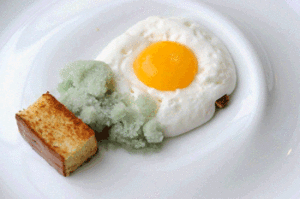
“Like Breakfast” — Iwasaki’s troupe l’oeil dessert
Your professional life in Japan before you moved to Italy had always been in Italian restaurants, how did it happen and why did you fall in love with Italian cuisine?
TI: I’ve always loved to cook and I started studying Italian dishes because I think it’s the most interesting and varied “national” cuisine.
Are there other chefs in your family?
TI: No, my father is a driver, my mother a teacher. My sister used to teach dance but now she’s a full-time mother.
How did you end up at Agli Amici in the tiny town of Godia?
TI: I’ve been in Italy for ten years and at Agli Amici for seven. I arrived in Godia purely by chance, thanks to a Japanese friend. It’s most curious because up until then I thought Italy ended in Venice. I didn’t know that there was a region of Italy farther north. I discovered a new world.
At first you worked in all departments of Agli Amici’s kitchen, why did you decide to change from being a regular chef to pastry?
TI: Becoming a pastry chef wasn’t a premeditated decision on my part. The opportunity presented itself and I’m very happy to have taken advantage of this chance.
Who was your mentor and what did you learn from him?
TI: I take advantage of all the opportunities that come my way. I’m very patient, but, when I’m given a chance, I go for it heart-and-soul. I didn’t and don’t have an “Osho.” I learned the basics of cooking in Japan from my teacher named Aihara. The rest is motion, natural evolution, doing what comes naturally, following my instincts.
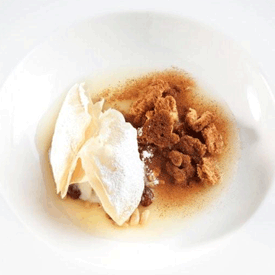
Il dolce di una terra senza confini — Oltre lo Strudel
What are the essential qualities of a top chef?
TI: Determination, a desire to learn, and curiosity.
What are the essential qualities of being a top pastry chef?
TI: My experience as a pastry chef is limited to working in restaurants. Nevertheless a top pastry chef must have the same qualities as a general top chef. A top pastry chef in a restaurant should be curious yet attentive to the balance of the entire menu.
How is it different from being a top chef?
TI: A top chef oversees and supervises the work of the restaurant’s whole kitchen team, including the pastry chef. The pastry chef is in-charge of his or her team only. At Agli Amici all the chefs have the chance to create and freely try out our culinary creations from antipasti to desserts. As far as the sweets are concerned, Emanuele and I discuss and make the final decisions together about which ones to put on the menu.
When I think of Japanese cuisine, I don’t think of sweets; can you describe some?
TI: Have you ever tasted Ohagi, youkan, zenzai…? They’re quite common and popular Japanese sweets made with a bean and rice base. In Japan’s elegant top restaurants the pastries are more refined and French-influenced, the usual classics.
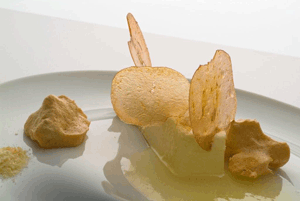
Cheesecake at Agli Amici
At “IdentitàGolose” you explained the differences between Japanese and Western sweets, but can you tell my readers?
TI: In the West often a dish will present a mixture of tastes, for example in tiramisu. Instead in Japan we seldom put more than three or four ingredients in a dish. The ingredients are put together in such a way, that mouthful after mouthful, we separate out the most immediate sensations. For example in apple pie with ice cream, first we notice the hotness of the pie, then its sweetness, then the coldness of the ice cream, and lastly its creaminess. As far as my work is concerned I constantly ask myself the same three fundamental questions: Where? When? And How much?
Where am I eating this dessert? In a restaurant, not in a café or pastry shop. My guest orders a dessert only imagining what it will be like. We don’t have a dessert cart or display case like the ones in pastry shops.
When? After a full meal, which has already been rich in flavors and smells, the dessert must be fresh and light.
How much? Only a little bit. At the end of a meal there’s no need for a large amount of dessert. It’s only a way to the pleasure of discovering new flavors, of giving more new sensations to our guests. A dessert mustn’t weigh heavy on the stomach.
What is still Japanese about your desserts after so many years in Italy?
TI: The comparison, the differences between Italian and Japanese cuisine and then more generally with my life here where I was reborn and found myself have given me a deeper awareness of my Japanese origins. The Japanese sense of the consistency, of the temperature, and the pleasure of balance, are still noticeable in my cooking.
What do you like best about your work?
TI: The possibility to develop and improve my skills every day and the constant search for perfection in my work.
The least?
TI: The long hours.
What’s your culinary philosophy?
TI: Amaze but with taste rather than with technique.
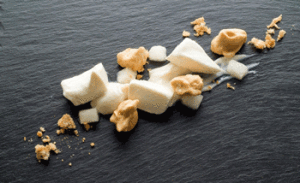
Cagliata
What are your signature sweets and other specialties?
TI: My first dessert on Agli Amici’s menu was basil ice cream with plums in brown sugar and toasted pine nuts. My specialty is a white chocolate cagliata or curd. It has a marvelous consistency.
Pastry chefs you admire?
TI: Both from the professional and human point-of-view: Gianluca Fusto, Yann Duytsche, and Loretta Fanella.
Your feelings about food critics and restaurant guides: have they been helpful to you or do they only add stress?
TI: I believe in them. They’re useful to professionals in the hospitality and restaurant business because they help us to find out how our work, talents, creations, in my case desserts, are perceived and judged by others.
Up to now we talked about Tatsuya Iwasaki the chef; I’d like to know more about Tatsuya Iwasaki himself. For example, what are your favorite foods?
TI: I love sushi, soba, and spaghetti.
Your favorite desserts?
TI: Ice cream, but whenever I go to a restaurant I order tiramisu — it’s a surprise every time.
A dish you don’t like?
TI: I can’t think of any — well-prepared food is always good.
Your favorite wines?
TI: I always look for freshness in a wine. I especially like sparkling and white wines, in particular Sauvignons; the ones from Friuli are delicious.
Design is a crucial element in your dishes; what are your favorite colors?
TI: The colors found in nature: the white of clouds, sky-blues, the blues of the sea and forest-greens.
What do you miss most about Japan?
TI: The food, my family, and my old friends and in that order! My family and old friends can come and visit me whenever they want…but Japanese food, authentic Japanese food, can only be eaten in Japan!
Chefs are well-known for having collections, often of fast cars, motorcycles, or watches; what about you?
TI: Trips and sky-miles.
If you hadn’t become a pastry chef, what profession would you have chosen?
TI: An airplane pilot.
& & &
